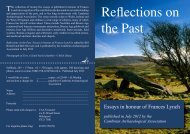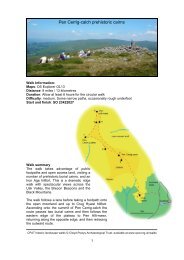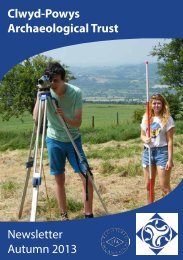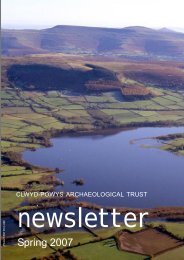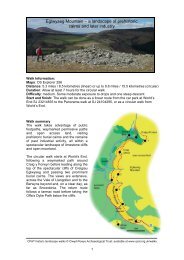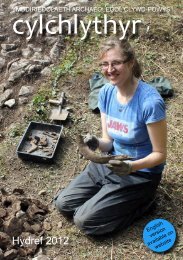Datganiad Cadwraeth Clawdd Offa Offa's Dyke Conservation ...
Datganiad Cadwraeth Clawdd Offa Offa's Dyke Conservation ...
Datganiad Cadwraeth Clawdd Offa Offa's Dyke Conservation ...
Create successful ePaper yourself
Turn your PDF publications into a flip-book with our unique Google optimized e-Paper software.
27 <strong>Datganiad</strong> <strong>Cadwraeth</strong> <strong>Clawdd</strong> <strong>Offa</strong><strong>Offa</strong>'s <strong>Dyke</strong> <strong>Conservation</strong> Statement 27Achosion erydiad5Causes of erosionDifrod parhaus i’r clawddContinuing damage to the dyke5.1 Nid ffenomenon hanesyddol yn unig mo’r broses oddifrod i Glawdd <strong>Offa</strong> (gweler adran 3), ond bygythiadgwirioneddol heddiw.5.2 Dangosir y broblem orau mewn ymchwil a wnaed ynddiweddar gan Cadw (Burnham 1992) i fesur cyflwr y 60 km oGlawdd <strong>Offa</strong> sydd yng Nghymru. Canfu’r astudiaeth, a oeddyn seiliedig ar gyfuniad o waith maes a dadansoddiaddogfennau, bod 51% o’r henebyn archaeolegol enwocaf yngNghymru naill ai eisoes mewn cyflwr gwael o ran cadwraeth,neu wedi ei ddinistrio yn llwyr. O ystyried bod elfen sylweddolo’r dirywiad hwnnw yn adlewyrchu difrod cyn yr 20fed ganrif,yr hyn sydd efallai yn fwy arwyddocaol yw yr ystyriwyd bod32% o’r clawdd sydd ar ôl dan fygythiad difrifol o ddirywiadpellach heddiw. Yn wir, cafwyd bod y clawdd yng Nghymru arhyn o bryd yn dioddef difrod ar raddfa o 130 medr y flwyddyn,ac os bydd hyn yn parhau, byddai’r gwrthglawdd cyfan ynwynebu diflaniad llwyr ymhen 150 o flynyddoedd yn unig. Trabo’r ffigwr hwn yn broffwydoliaeth ystadegol braidd sy’ncuddio llawer o gymhlethdodau yn y patrwm gwirioneddol obwysau ar yr henebyn, mae’n dangos maint y broblemgadwraeth y mae <strong>Clawdd</strong> <strong>Offa</strong> yn ei gynrychiolir.Atgyfnerthwyd y neges honno gan arolwg ansoddol manwl ogyflwr darnau Cymreig y clawdd yn Siroedd Trefaldwyn aMaesyfed (Burnham 1997 a 1998).5.3 Er na wnaed gwaith ymchwil cymharol ar gyfer y cyfano’r clawdd yn Lloegr, mae’r gwaith sydd wedi ei wneud yndangos darlun tebyg iawn, rhywbeth na ddylai beri syndod(Leigh 1996, Mcglade 1996, Hoyle a Vallender 1997). Maedadansoddiad manwl gan Wasanaeth Archaeoleg SwyddGaerloyw o’r 15.2km o’r clawdd sy’n goroesi yn SwyddGaerloyw wedi dangos bod 20% (yn ôl arwynebedd) o’rhenebyn ar hyn o bryd yn destun prosesau erydu gweithredol.At hynny, cafwyd bod y rhan fwyaf o’r difrod hwnnw — 15%(yn ôl arwynebedd) o’r henebyn — yn ddifrod o natur ddifrifolneu ddifrifol iawn. Byddai tystiolaeth yr arolwg archaeolegolo’r clawdd yn y sir hefyd yn awgrymu — ar y dybiaeth bodllawer o’r bylchau yn y gwrthglawdd gweledol yn cynrychiolidifrod yn y gorffennol — bod y canran o’r henebyn syddeisoes wedi mynd yn sylweddol, er yn anodd ei fesur yn union.5.4 Caiff y darlun o ben i ben ei gadarnhau trwy gyfrwngdata a gasglwyd fel rhan o arolwg cyflwr llwybr GwasanaethRheoli Llwybr <strong>Clawdd</strong> <strong>Offa</strong> (Cutts 1988). Gan ddadansoddicyflwr y clawdd fel a welir o’r llwybr (Cymru a Lloegr),gwelwyd bod 38% o’r henebyn yn dioddef erydiadgweithredol, gyda 5% mewn cyflwr gwael iawn.5.1 The process of active damage to <strong>Offa</strong>’s <strong>Dyke</strong> is not just ahistorical phenomenon (see section 3), but very much apressing threat today.5.2 The problem is best illustrated in recent research byCadw (Burnham 1992) to quantify the state of the 60 km of<strong>Offa</strong>’s <strong>Dyke</strong> in Wales. The study, based on a combination offield work and documentary analysis, found that 51% of thearchaeologically known monument in Wales was alreadyeither poorly preserved or completely destroyed. Given thata considerable element of that degradation reflects pre-20thcentury change, what is perhaps more significant is that 32%of the remaining dyke was perceived to be under seriousthreat of further deterioration today. Indeed, the dyke inWales was found to be currently suffering damage at the rateof 130 metres each year, with the earthwork facing completedisappearance in only 150 years at this rate of destruction.While this latter calculation is something of a statisticalprediction which hides many complexities in the real patternof pressures on the monument, it still graphically illustratesthe scale of the conservation problem represented by <strong>Offa</strong>’s<strong>Dyke</strong>. That message has further been driven home bydetailed qualitative condition survey of Welsh sections ofthe dyke in Montgomery and Radnorshire (Burnham 1997and 1998).5.3 Although comparable research for the complete length ofdyke in England has not been undertaken, the work that hasbeen done unsurprisingly reveals a very similar picture (Leigh1996, Mcglade 1996, Hoyle and Vallender 1997). Detailedanalysis by the Gloucestershire County Council ArchaeologyService of the 15.2 km of surviving dyke in Gloucestershire hasshown that 20% (by area) of the monument is currentlysubject to active erosion processes. Moreover, most of thatdamage — 15% (by area) of the monument — was held to beof a serious or very serious nature. The evidence of thearchaeological survey of the dyke in the county would alsoindicate — on the presumption that the many gaps in thevisible earthwork represent its past destruction — that thepercentage of the monument which is already completely lostis considerable, though hard to quantify exactly.5.4 The overall picture is confirmed through data collectedas part of the recent <strong>Offa</strong>’s <strong>Dyke</strong> Path Management Servicepath condition survey (Cutts 1998). Analysing the state of thedyke as viewed from the path (England and Wales), 38% of themonument was seen to be suffering active erosion, with 5%classified as in very poor condition.



